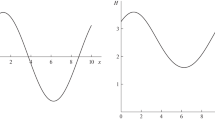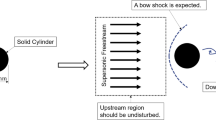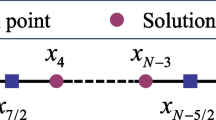Abstract
We perform a comparative analysis of the accuracy of the weighted essentially nonoscillatory (WENO), compact high-order weak approximation (CWA), and central-upwind (CU) schemes used to compute discontinuous solutions containing shocks propagating with variable velocity. We demonstrate that the the accuracy of the formally high-order WENO and CU schemes, which are constructed using nonlinear flux correction mechanisms, reduces to approximately first order integral convergence on intervals in which one of the endpoints is in the region of influence of a shock wave. At the same time, the CWA scheme, which is designed to be high-order in the weak sense and does not rely on any nonlinear flux corrections, retains approximately the second order of integral convergence even in the regions of influence of shock waves. As a result, in these areas, the accuracy of the WENO and CU schemes is significantly lower than the accuracy of the CWA scheme. We provide a theoretical justification of these numerical results.




Similar content being viewed by others
REFERENCES
S. K. Godunov, “A difference method for numerical calculation of discontinuous solutions of the equations of hydrodynamics,” Mat. Sb. 47 (3), 271–306 (1959).
B. van Leer, “Toward the ultimate conservative difference scheme. V. A second-order sequel to Godunov’s method,” J. Comput. Phys. 32 (1), 101–136 (1979). https://doi.org/10.1016/0021-9991(79)90145-1
A. Harten, “High resolution schemes for hyperbolic conservation laws,” J. Comput. Phys. 49 (3), 357–393 (1983). https://doi.org/10.1016/0021-9991(83)90136-5
A. Harten and S. Osher, “Uniformly high-order accurate nonoscillatory schemes. I,” SIAM J. Numer. Anal. 24 (2), 279–309 (1987). https://doi.org/10.1137/0724022
H. Nessyahu and E. Tadmor, “Non-oscillatory central differencing for hyperbolic conservation laws,” J. Comput. Phys. 87 (2), 408–463 (1990). https://doi.org/10.1016/0021-9991(90)90260-8
X.-D. Liu, S. Osher, and T. Chan, “Weighted essentially non-oscillatory schemes,” J. Comput. Phys. 115 (1), 200–212 (1994). https://doi.org/10.1006/jcph.1994.1187
G. S. Jiang and C.-W. Shu, “Efficient implementation of weighted ENO schemes,” J. Comput. Phys. 126 (1), 202–228 (1996). https://doi.org/10.1006/jcph.1996.0130
B. Cockburn, “An introduction to the discontinuous Galerkin method for convection-dominated problems,” in Advanced Numerical Approximation of Nonlinear Hyperbolic Equations, Ed. by A. Quarteroni, Lecture Notes in Mathematics, Vol. 1697 (Springer, Berlin, 1998), pp. 150–268. https://doi.org/10.1007/BFb0096353
A. Kurganov and E. Tadmor, “New high-resolution central schemes for nonlinear conservation laws and convection-diffusion equations,” J. Comput. Phys. 160 (1), 241–282 (2000). https://doi.org/10.1006/jcph.2000.6459
A. Kurganov, S. Noelle, and G. Petrova, “Semidiscrete central-upwind schemes for hyperbolic conservation laws and Hamilton–Jacobi equations,” SIAM J. Sci. Comput. 23 (3), 707–740 (2001). https://doi.org/10.1137/S1064827500373413
S. A. Karabasov and V. M. Goloviznin, “Compact Accurately Boundary-Adjusting high-REsolution Technique for fluid dynamics,” J. Comput. Phys. 228 (19), 7426–7451 (2009). https://doi.org/ /10.1016/j.jcp.2009.06.037
V. M. Goloviznin, M. A. Zaitsev, S. A. Karabasov, and I. A. Korotkin, New CFD Algorithms for Multiprocessor Computer Systems (Mosk. Gos. Univ., Moscow, 2013) [in Russian].
V. V. Ostapenko, “Convergence of finite-difference schemes behind a shock front,” Comput. Math. Math. Phys. 37 (10), 1161–1172 (1997).
J. Casper and M. H. Carpenter, “Computational consideration for the simulation of shock-induced sound,” SIAM J. Sci. Comput. 19 (3), 813–828 (1998). https://doi.org/10.1137/S1064827595294101
B. Engquist and B. Sjögreen, “The convergence rate of finite difference schemes in the presence of shocks,” SIAM J. Numer. Anal. 35 (6), 2464–2485 (1998). https://doi.org/10.1137/S0036142997317584
O. A. Kovyrkina and V. V. Ostapenko, “On the convergence of shock-capturing difference schemes,” Dokl. Math. 82 (1), 599–603 (2010). https://doi.org/10.1134/S1064562410040265
O. A. Kovyrkina and V. V. Ostapenko, “On the practical accuracy of shock-capturing schemes,” Math. Models Comput. Simul. 6 (2), 183–191 (2014). https://doi.org/10.1134/S2070048214020069
O. A. Kovyrkina and V. V. Ostapenko, “On the construction of combined finite-difference schemes of high accuracy,” Dokl. Math. 97 (1), 77–81 (2018). https://doi.org/10.1134/S1064562418010246
N. A. Zyuzina, O. A. Kovyrkina, and V. V. Ostapenko, “Monotone finite-difference scheme preserving high accuracy in regions of shock influence,” Dokl. Math. 98 (2), 506–510 (2018). https://doi.org/10.1134/S1064562418060315
M. E. Ladonkina, O. A. Neklyudova, V. V. Ostapenko, and V. F. Tishkin, “On the accuracy of the discontinuous Galerkin method in calculation of shock waves,” Comput. Math. Math. Phys. 58 (8), 1344–1353 (2018). https://doi.org/10.1134/S0965542518080122
O. A. Kovyrkina and V. V. Ostapenko, “On monotonicity and accuracy of CABARET scheme for calculation of weak solutions with shocks,” Vychisl. Tekhnol. 23 (2), 37–54 (2018). https://doi.org/10.25743/ICT.2018.23.12757
O. A. Kovyrkina and V. V. Ostapenko, “Accuracy of MUSCL-type schemes in shock wave calculations,” Dokl. Math. 101 (3), 209–213 (2020). https://doi.org/10.1134/S1064562420030126
V. V. Ostapenko, “Finite-difference approximation of the Hugoniot conditions on a shock front propagating with variable velocity,” Comput. Math. Math. Phys. 38 (8), 1299–1311 (1998).
V. V. Rusanov, “Difference schemes of the third order of accuracy for continuous computation of discontinuous solutions,” Sov. Math. Dokl. 9 (6), 771–774 (1968).
V. V. Ostapenko, “Construction of high-order accurate shock-capturing finite-difference schemes for unsteady shock waves,” Comput. Math. Math. Phys. 40 (12), 1784–1800 (2000).
M. E. Ladonkina, O. A. Neklyudova, V. V. Ostapenko, and V. F. Tishkin, “Combined DG scheme that maintains increased accuracy in shock wave areas,” Dokl. Math. 100 (3), 519–523 (2019). https://doi.org/10.1134/S106456241906005X
A. Kurganov and C.-T. Lin, “On the reduction of numerical dissipation in central-upwind schemes,” Commun. Comput. Phys. 2 (1), 141–163 (2007). http://global-sci.org/intro/ article_detail/cicp/7900.html
P. D. Lax, Hyperbolic Systems of Conservation Laws and the Mathematical Theory of Shock Waves (Soc. Ind. A-ppl. Math., Philadelphia, 1972).
B. L. Roždestvenskii and N. N. Janenko, Systems of Quasilinear Equations and Their Applications to Gas Dynamics, 2nd ed. (Nauka, Moscow, 1978; Am. Math. Soc., Providence, RI, 1983).
P. D. Lax and B. Wendroff, “Systems of conservation laws,” Commun. Pure Appl. Math. 13 (2), 217–237 (1960). https://doi.org/10.1002/cpa.3160130205
S. Gottlieb, C.-W. Shu, and E. Tadmor, “Strong stability-preserving high-order time discretization methods,” SIAM Rev. 43 (1), 89–112 (2001). https://doi.org/10.1137/S003614450036757X
S. Gottlieb, D. Ketcheson, and C.-W. Shu, Strong Stability Preserving Runge–Kutta and Multistep Time Discretizations (World Scientific, Hackensack, NJ, 2011). https://doi.org/10.1142/7498
C.-W. Shu, “Essentially non-oscillatory and weighted essentially non-oscillatory schemes,” Acta Numer. 29, 701–762 (2020). https://doi.org/10.1017/S0962492920000057
R. S. Hirsh, “Higher order accurate difference solutions of fluid mechanics problems by a compact differencing technique,” J. Comput. Phys. 19 (1), 90–109 (1975). https://doi.org/10.1016/0021-9991(75)90118-7
A. E. Berger, J. M. Solomon, M. Ciment, S. H. Leventhal, and B. C. Weinberg, “Generalized OCI schemes for boundary layer problems,” Math. Comput. 35 (6), 695–731 (1980). https://doi.org/10.1090/S0025-5718-1980-0572850-8
O. M. Belotserkovskii, A. P. Byrkin, A. P. Mazurov, and A. I. Tolstykh, “Higher-order accuracy difference method for computing viscous gas flows,” USSR Comput. Math. Math. Phys. 22 (6), 206–216 (1982). https://doi.org/10.1016/0041-5553(82)90110-0
A. I. Tolstykh, Compact Difference Schemes and Their Application to Problems of Aerohydrodynamics (Nauka, Moscow, 1990) [in Russian].
V. V. Ostapenko, “Symmetric compact schemes with artificial viscosities of increased order of divergence,” Comput. Math. Math. Phys. 42 (7), 980–999 (2002).
R. W. MacCormack, “The effect of viscosity in hypervelosity impact cratering,” AIAA Paper 69-354 (1969);
J. Spacecr. Rockets 40 (5), 757–763 (2003). https://doi.org/10.2514/2.6901
J. J. Stoker, Water Waves: The Mathematical Theory with Applications (Wiley, New York, 1957; Inostr. Lit., M-oscow, 1959).
Funding
This study was financially supported by the Russian Foundation for Basic Research and the National Natural Science Foundation of China (NSFC) as part of scientific project no. 21-51-53012 and was partially supported by NSFC grants nos. 11771201 and 1201101343, as well as by the Guangdong Provincial Foundation, Laboratory of Computing and Materials Science (no. 2019B030301001).
Author information
Authors and Affiliations
Corresponding authors
Ethics declarations
The authors declare that they have no conflicts of interest.
Rights and permissions
About this article
Cite this article
Kovyrkina, O.A., Kurganov, A.A. & Ostapenko, V.V. Comparative Analysis of the Accuracy of Three Different Schemes in the Calculation of Shock Waves. Math Models Comput Simul 15, 401–414 (2023). https://doi.org/10.1134/S2070048223030092
Received:
Revised:
Accepted:
Published:
Issue Date:
DOI: https://doi.org/10.1134/S2070048223030092




